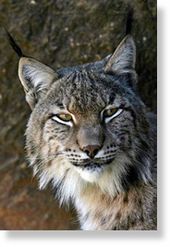
© Reuters
The Iberian lynx has seen numbers drop to between just 84 and 143 adults
A quarter of the world's mammals are at risk of extinction, the latest global analysis of threatened species revealed today.
At least 1,141 of the 5,487 mammals on Earth are under threat, largely as a result of hunting and the destruction of their habitat by humans, according to the International Union for the Conservation of Nature (IUCN).
The latest IUCN Red List of Endangered Species showed 188 species are critically endangered - including the Iberian lynx which has seen numbers drop to between just 84 and 143 adults.
There is evidence that more than half of all mammal species are experiencing declines in populations, according to the new study.
Recent analysis focusing on primates painted an even gloomier picture for them, with around half the world's monkey and ape species facing extinction - a figure which rises to four fifths of those found in South and South East Asia.
And conservationists warned the overall proportion of threatened mammals could in fact be as high as a third, because there isn't enough information on around 836 species to tell if they are in danger of extinction.
The news of the plight of mammals prompted IUCN director general Julia Marton-Lefevre to call for conservation action "to ensure our enduring legacy is not to wipe out many of our closest relatives".
"Within our lifetime hundreds of species could be lost as a result of our own actions, a frightening sign of what is happening to the ecosystems where they live," she warned
China's Pere David deer is listed as extinct in the wild in the first comprehensive analysis of mammals since 1996, although there are some hopes the species could reintroduced into the wild from captive populations.
But it may be too late to help a further 29 species which are flagged as critically endangered, possibly extinct - because it is thought they have in probability already died out in the wild.
Other species such as the Tasmanian devil, the Caspian seal and Southeast Asia's fishing cat have also seen their fortunes plummet, and are now among the 450 mammals which are listed as endangered.
One of the major impacts on mammals is destruction of their habitat, which affects two fifths of land species, according to the research published at the IUCN's world conservation congress and in the journal Science.
Other threats include hunting for food, medicine and materials, while marine mammals are most at risk of being caught by mistake by fishing boats, colliding with vessels and from pollution.
Jan Schipper, of Conservation International and lead author of the study, also said climate change would also have an impact on some species.
But there is good news for some mammals, with around 5% showing signs of recovery - suggesting conservation efforts can make a difference.
The black-footed ferret was moved from extinct in the wild to endangered after a successful reintroduction programme in the US, while the wild horse has come back from extinction in the wild to critically endangered following similar schemes in Mongolia.
And in another piece of good news, the African elephant was downgraded from vulnerable to extinction to the lower category of near threatened, because of recent increases in population in southern and eastern Africa.
Overall, the IUCN Red List now includes 44,838 species, of which almost two fifths fall into the three categories - critically endangered, endangered or vulnerable - which mean they are at risk of extinction.
The Rameshwaram parachute spider has been listed as critically endangered because its natural habitat has been almost entirely destroyed while the Cuban crocodile has become critically endangered because of illegal hunting for its meat and skin.
And amphibians are facing a global extinction crisis, with a third of species threatened or extinct, the 2008 Red List shows.
Reader Comments
to our Newsletter